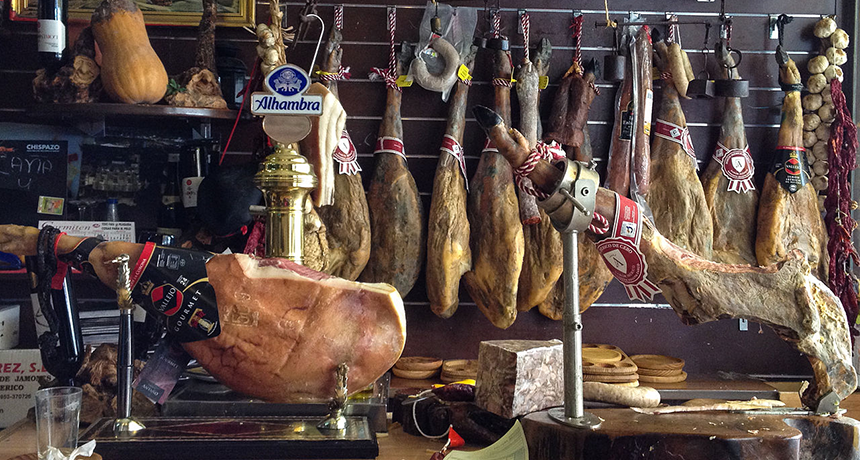Ham bone broth could be a tonic for the heart
Simmering Spanish ham bones releases heart-healthy chemicals

Broth from the bones of Spanish dry-cured ham, like that shown here, could boost heart health, new data suggest.
Michal Osmenda/Wikimedia Commons (CC-BY-2.0)
Google the term “bone broth.” You’ll quickly discover people claiming that it’s the latest miracle cure. Broth made from animal bones simmered up to 20 hours can heal your gut, boost your immune system, reduce cellulite, strengthen teeth and bones, tackle inflammation and much more. Or that’s what a host of health and fitness websites claim. But there’s been little research to support those claims — until now. Researchers in Spain report promising signs that broth from dry-cured ham bones might help protect the heart.
Leticia Mora works at the Institute of Agrochemistry and Food Technology in Valencia, Spain. She didn’t set out to validate health claims of bone-broth fans. This biochemist is merely interested in the chemistry of meat. “The processing of meat involves a lot of changes in terms of biochemistry,” she explains.
Cooking meat releases nutrients that the body can absorb. As we digest meat and related products such as broth, our bodies interact with those compounds. What happens during these interactions interests Mora. She also has a practical reason to investigate the biochemistry of bone broth: The meat industry throws out most animal bones as waste. Says Mora, “I wanted to find a way to use them in a healthy way.”
Many Spanish dishes include bone broth. So Mora had a good idea of how to make it. She turned her lab into a kitchen and concocted a broth with only water and dry-cured ham bones. Most cooks flavor bone broths with vegetables. But Mora wasn’t looking for flavor. She was searching for protein bits known as peptides that had been released by the bones.
The long process of cooking broth breaks bone proteins into those peptides, which are short chains of amino acids. There are many different types of peptides. Some can help the body’s cardiovascular system, that heart and blood-transporting network. Such peptides can help block certain natural chemicals called enzymes that can increase blood pressure. When Mora finished cooking her broth, she analyzed what chemicals it now contained. The “interesting results,” she says, showed the heart-healthy peptides were there.
Her team described its findings online January 30 in the Journal of Agricultural and Food Chemistry.
Probing the role of digestion
The researchers also wanted to find out what happens to the peptides when bone broth is digested. Other types of enzymes help break down foods. “Sometimes, the enzymes interacting in the stomach can act on the proteins that we eat, and they can also affect the peptides in the broth,” Mora explains. “We wanted to be sure that these peptides are still there after all the … conditions of the stomach [act on the broth].”
In other words, she wanted to know if the stomach acids, enzymes and more might destroy any heart-friendly peptides in the broth before the body had a chance to move them into your blood. To test that, Mora decided to simulate digestion in her lab. She gathered all the liquids found in our digestive system and let them mingle with the broth. After two hours, the time it would take us to digest broth, she analyzed the broth again. And the good ham-bone peptides were still there.
This suggests bone broth’s heart-helping peptides can survive long enough to enter the bloodstream. That’s where they need to be to block the enzymes that put people at risk for heart disease.
But Mora can’t say for sure that’s the case — yet. Sometimes, experiments in the lab don’t mimic what happens in the body. That’s why Mora now hopes to study bone broth in people. One idea: Measure people’s blood pressure before and after they drink a certain amount of bone broth for a month. If blood pressures are lower at the end of the month, Mora might infer that bone broth is indeed good for the heart.
So, is Mora’s experiment enough to support bone broth’s status as a miracle cure? Not by a long shot. More research is needed to test each of the claims made by wellness gurus and companies. But her team’s data do show that it’s worth following up to probe any true benefits of slow-simmered bones.







